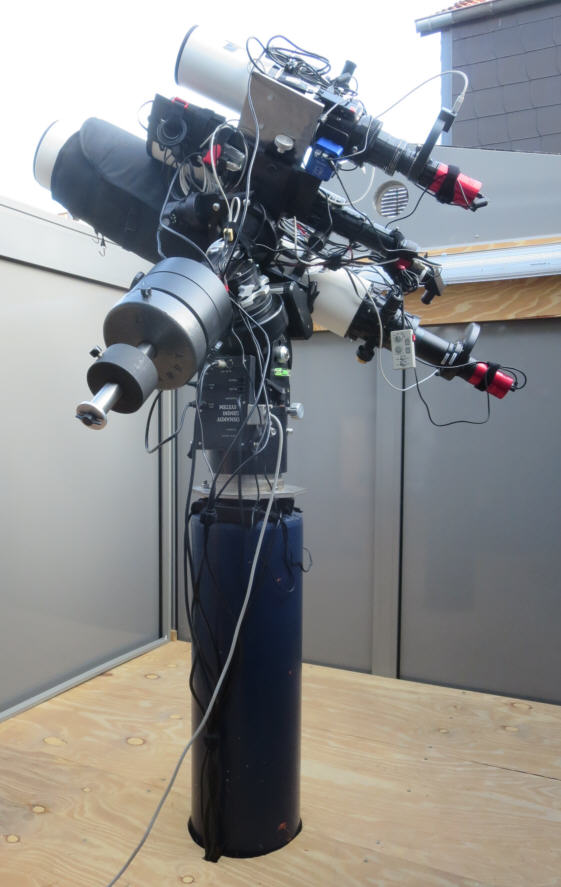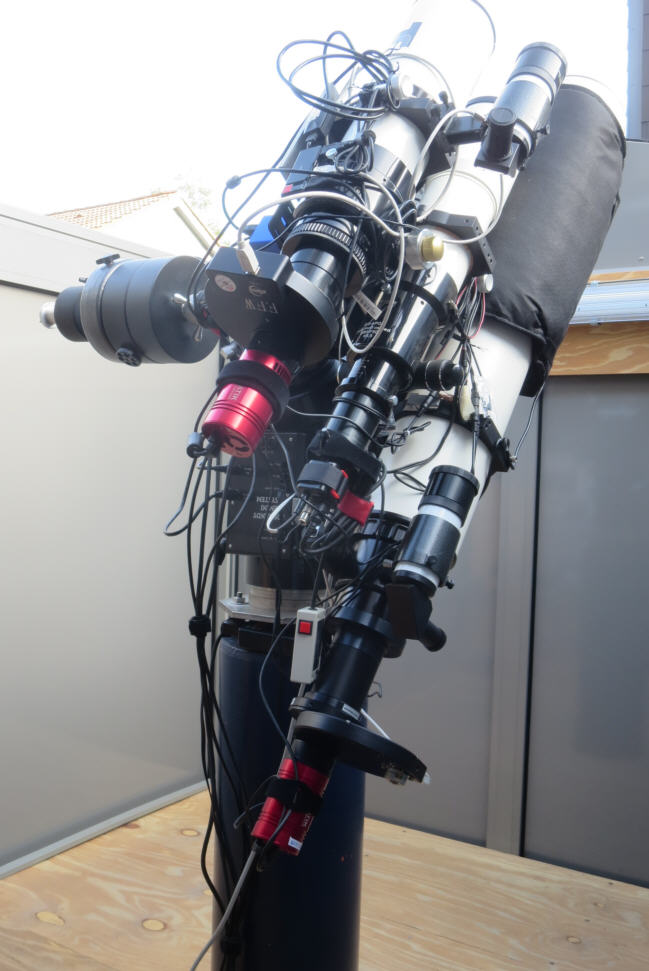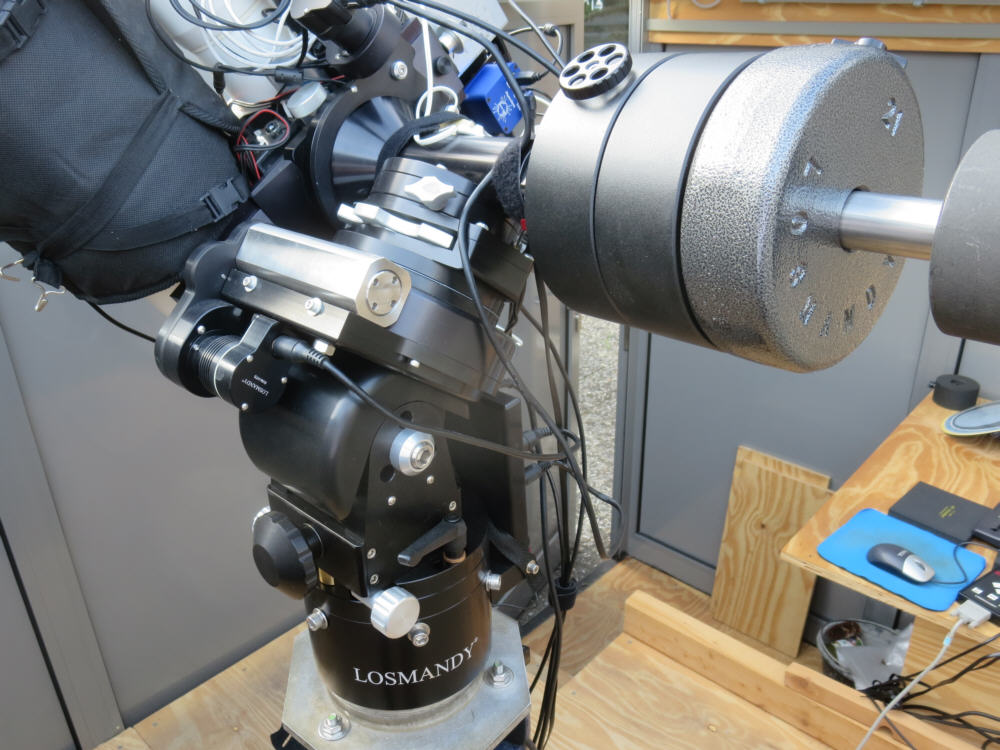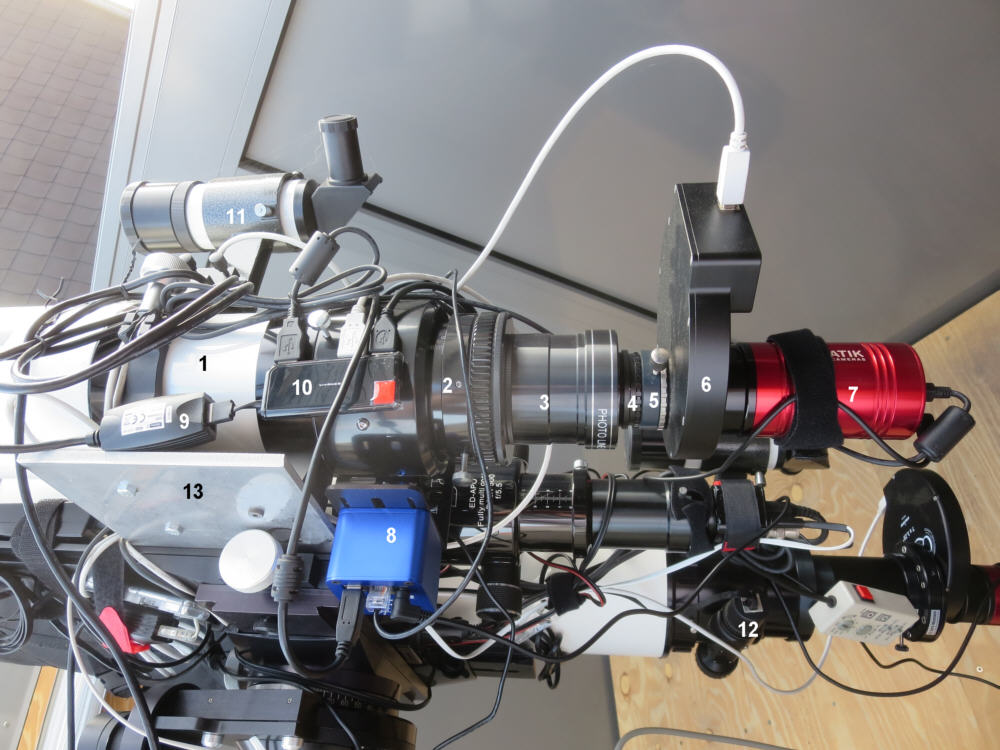

CCD camera Atik 490EX attached to the small refractor
With the 140mm refractor I achieve an image field size of about 60' x 45' at 750mm focal length when using the Riccardi reducer and the sensor size of the Atik 460EX. This is a quite nice focal length to image galaxies, planetary nebulae, globular clusters and most of the open clusters. However, many emission nebulae and old supernova remnants are much larger. To make these objects (at least most of them) fit into the frame I considered to buy another refractor with a much shorter focal length. I choose a China made 80mm apochromatic refractor offered from Telescope Service (TS). The 3" focusser was compatible with the Riccardi reducer, so I could use it both for the large and the small refractor. However, I never changed the imaging train and never mounted the reducer to the small refractor. The time consuming adjustments and the risk that dust could enter the imaging train stopped me from doing this. I purchased a 2.5" reducer from TS instead that reduces the focal length by a factor of 0.79X resulting in f=380mm and f/4.8. The camera sensor of the Atik 490EX has the same size as the one of the 460EX, so that the image field size is now about 2° x 1.5°. The resolution per pixel is somewhat smaller and is only 62% of the resolution that I achieve with the large refractor and the Atik 460EX.
The 80mm refractor is equipped with two tube rings and a mounting bracket. The latter is necessary to mount the refractor to e.g. a tripod. For mounting the refractor on a dove tail plate the tube rings come handy and the mounting bracket has to be removed. I mounted the 80mm refractor and the 90mm refractor parallel on an aluminium plate that is mounted on a dove tail plate to mount the small refractors side by side to the large one on the mount. The refractors are mounted on the aluminium plate using the mounting brackets at their rear ends and the tube rings at the front ends. Luckily the tube of the 90mm refractor has a slightly smaller diameter than the tube of the 80mm refractor. Although the smaller refractors are fairly parallel, they are not exactly parallel to the large on. There is a difference of nearly one degree that the large refractor points higher. At first I thought about correcting this difference but then I left it as is. The small angular difference is of no importance for guiding. But when taking images the 80mm refractor sees an image field adjacent to that of the large refractor. Instead of taking two images of the same object I now take two images of different objects with both refractors.
The 80mm refractor is equipped with a temperature compensating focusser motor from Pegasus Astro. The motor comes with an universal mounting bracket, couplings for all typical focusser axle diameters, an external temperature sensor and all necessary bolts and cables. The installation was no problem and was covered well by the instructions. The software to control the focusser motor had to be downloaded from Pegasus Astro's website and is easy to use. The focusser motor can either be controlled by a computer via USB or with an optional hand controller. The only task of the user is to evaluate the number of steps the focusser motor has to turn per degree temperature drop. This evaluation is also necessary for the focusser motor from Optec for the TEC-built focusser of the TEC 140. The Optec focusser has the temperature sensor inside the motor housing. An optional external temperature sensor can be attached. The built-in temperature sensor gets warm when the motor is working heavily when the initial focus is adjusted at the beginning of the imaging session. You should wait then a few minutes before telling the control software to adjust the focus based on the built-in temperature sensor. Otherwise the focus will be adjusted following the cooling motor although the ambient temperature did not drop. The Optec focusser motor has a special feature because it can be engaged and disengaged by turning it a small angle. Thus, the manual focusser can still be used. This is no longer possible with the 80mm refractor where the focusser motor from Pegasus Astro is permanently attached to the focusser axle. This focusser motor also comes in a larger housing because all the electronics are built into that housing. Optec needs a separate control box that can also control a second focusser motor.

My Losmandy G-11 nearly reached its capacity limit with the three telecopes on top of it. A completely new mount was an option but not very attractive to me because I liked the Gemini GoTo control and was used to it. Then I found that Losmandy was offering a modular concept for their mounts. To enhance the load capacity the DEC axis of your mount could be combined with the base and RA axis of the next larger mount. So I combined the base and RA axis of the Titan mount with the DEC axis of my G-11 and raised the capacity of the mount from 20 kg to 30 kg. A special adaptor holds both parts together. The base of the Titan is completely different from those of the smaller mounts which are all identical. The base has a diameter of 7" instead of 6" and needs a tube like that of the upper end of the Titan tripod to accept the base. Luckily I found that Losmandy offers an adaptor to mount the Titan on Meade's giant field tripod. This adaptor is like a pot with a flat bottom and all the holes necessary for Meade's tripod. All I had to do was drilling new holes for my adaptor plate on the pier and cutting threads for the bolts. This "pot" and the larger mount base raised the position of the telescopes by about 25 cm. So I had to define a new parking position in order to allow the observatory roof to close. The higher position lets the telescopes have a better view over the southern observatory wall.
Losmandy named the combination of the Titan base and the DEC axis of the G-11 as G11T. However the base for the G11T is not 100% identical to the base of the Titan. An important difference is the position of the motor. For the Titan the motor is below the RA axis, for the G11T it is upon the RA axis. This means that the length of your motor cable for the RA motor is too short. As a workaround I mounted the Gemini control unit upside down. Then the length is just acceptable but the cable has a sharp bend next to the plug. Unfortunately, Losmandy do not disclose on their website the necessary mount parameters that have to be entered in the Gemini control unit. Since I own the Gemini 1 it does not know the G11T right away and I have to use it as a custom mount. I found the necessary parameters on www.gemini-2.com. Even Losmandy refers to this (private) website for help and questions. The transmission ratio between the RA motor axis and the worm gear is twice as high for the Titan than for the G-11, thus, the motor has to run twice as fast as with the G-11 to move the RA axis for the same angle. The higher speed creates much more noise which might be an issue if the observatory is in the backyard and neighbouring houses are very close. How much quieter does the DEC motor work! I am quite disappointed of the noise of the RA motor and gearbox. Of course, you can reduce the moving speed and, thus, the noise but you have to wait much longer for the mount to finish the movement.
I placed all cables to the mount and equipment mounted there on close to the axes to avoid any entanglement of the cables with the mount during a movement. Also, the weight of the cables does not pull at the plugs or the DEC axis. Each of the telescopes with CCD cameras has its own USB cable with amplifier, USB hub and 12V power supply for camera, filter wheel, focusser and dew cap heater. Should one of the systems fail the other one should still work. Therefore, each camera is also equipped with a USB powered and controlled filter wheel for at least seven filters, i.e. LRGB filters, Hα, [OIII] and IR pass filters.

1 Telescope tube of 80mm TS refractor
2 3" focusser
3 2,5" reducer (0,79X) from TS
4 Adaptor from M48 to T2
5 Baader T2 ring dove tail coupling
6 ZWO Optical USB filter wheel "ESW" for 8 1,25" filters
7 Atik 490EX monochrome, cooled CCD camera with 9 megapixels
8 Pegasus Astro focusser motor for the 80mm refractor
9 Active USB extension cable
10 USB hub for camera, filter wheel and focusser motor for the 80mm refractor
11 Finder scope to bring bright stars easier into the field of view of the camera when the Gemini system has to be calibrated
12 Optec focusser motor for the TEC 140
13 Mounting plate for mounting the 90mm refractor and the 80mm refractor side by side